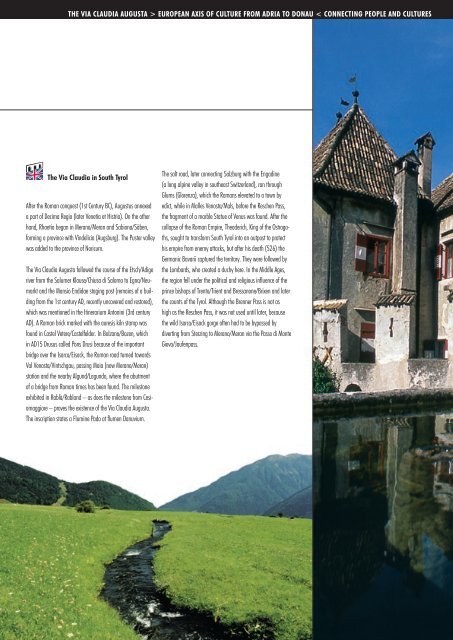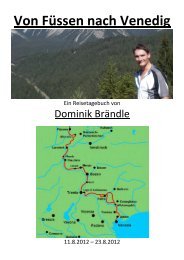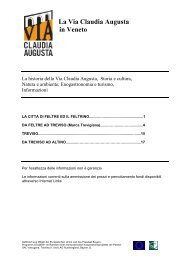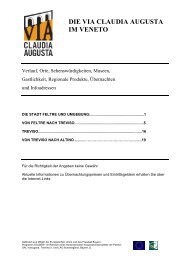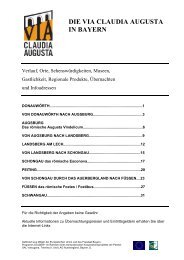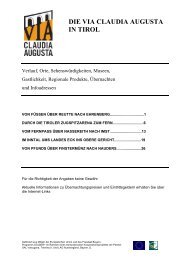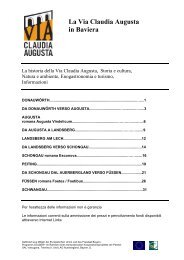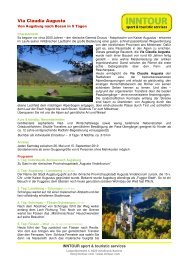VIA CLAUDIA AUGUSTA SALESGUIDE
VIA CLAUDIA AUGUSTA SALESGUIDE
VIA CLAUDIA AUGUSTA SALESGUIDE
You also want an ePaper? Increase the reach of your titles
YUMPU automatically turns print PDFs into web optimized ePapers that Google loves.
The Via Claudia auguSTa > european axiS of CulTure from adria To donau < ConneCTing people and CulTureS<br />
The Via Claudia in South Tyrol<br />
After the Roman conquest (1st Century BC), Augustus annexed<br />
a part of Decima Regio (later Venetia et Histria). On the other<br />
hand, Rhaetia began in Merano/Meran and Sabiona/Säben,<br />
forming a province with Vindelicia (Augsburg). The Puster valley<br />
was added to the province of Noricum.<br />
The Via Claudia Augusta followed the course of the Etsch/Adige<br />
river from the Salurner Klause/Chiusa di Salorno to Egna/Neumarkt<br />
and the Mansio Endidae staging post (remains of a building<br />
from the 1st century AD, recently uncovered and restored),<br />
which was mentioned in the Itinerarium Antonini (3rd century<br />
AD). A Roman brick marked with the auresis kiln stamp was<br />
found in Castel Vetere/Castelfelder. In Bolzano/Bozen, which<br />
in AD15 Drusus called Pons Drusi because of the important<br />
bridge over the Isarco/Eisack, the Roman road turned towards<br />
Val Venosta/Vintschgau, passing Maia (now Merano/Meran)<br />
station and the nearby Algund/Lagundo, where the abutment<br />
of a bridge from Roman times has been found. The milestone<br />
exhibited in Rablà/Rabland – as does the milestone from Cesiomaggiore<br />
– proves the existence of the Via Claudia Augusta.<br />
The inscription states a Flumine Pado at flumen Danuvium.<br />
The salt road, later connecting Salzburg with the Engadine<br />
(a long alpine valley in southeast Switzerland), ran through<br />
Glurns (Glorenza), which the Romans elevated to a town by<br />
edict, while in Malles Venosta/Mals, before the Reschen Pass,<br />
the fragment of a marble Statue of Venus was found. After the<br />
collapse of the Roman Empire, Theoderich, King of the Ostrogoths,<br />
sought to transform South Tyrol into an outpost to protect<br />
his empire from enemy attacks, but after his death (526) the<br />
Germanic Bavarii captured the territory. They were followed by<br />
the Lombards, who created a duchy here. In the Middle Ages,<br />
the region fell under the political and religious influence of the<br />
prince bishops of Trento/Trient and Bressanone/Brixen and later<br />
the counts of the Tyrol. Although the Brenner Pass is not as<br />
high as the Reschen Pass, it was not used until later, because<br />
the wild Isarco/Eisack gorge often had to be bypassed by<br />
diverting from Sterzing to Merano/Meran via the Passo di Monte<br />
Giovo/Jaufenpass.


